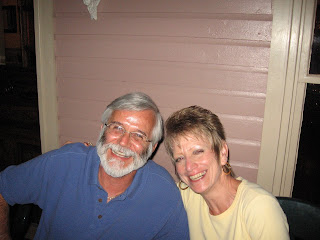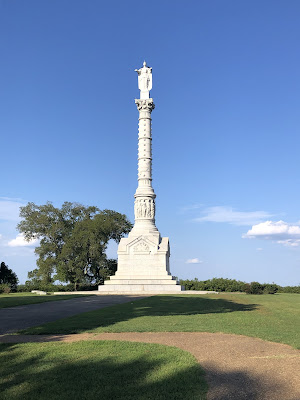We really enjoyed our time in WashPA but it was time to head home to Stuart. Our plan was to stay in Williamsburg, VA for a week then to Hatteras Island for another week before a quick couple day sprint to Florida. As we learned during our 12 plus years on the road, plans don't always go as expected.
We were last in the Williamsburg area in 2007, our first year on the road. We wanted to get a couple stamps in our national parks passport and just relax after our busy time in WashPA. Our first stop in the Colonial National Historical Park was Yorktown Victory Monument. The resolution to build a monument celebrating the October 19, 1781 surrender of Cornwallis to George Washington was passed by Congress 10 days after the event. That said, the cornerstone of the monument was not laid until October 18, 1881, one hundred years later.
The capital of Virginia was moved from Jamestown to Williamsburg in 1699. It was moved to its present location, Richmond, in 1780. Many of the 18 century buildings survived and in 1926 a reconstruction, funded by John D. Rockefeller Jr, began that preserved the buildings that are Colonial Williamsburg today. This is the Governor's Palace.
Duke of Gloucester (DOG) Street is lined with old shops and taverns.
Burton Parish Church was opened in 1677.
More building along DOG.
Carriage rides are available for those who wish to really step back in time. You can walk all the streets to see the buildings, as we opted to do, or you can buy a ticket to tour them. We enjoyed Williamsburg and were pleasantly surprised to find several very good local restaurants.
The third historical site located here is Historic Jamestowne, where, in 1607, the first European settlement to survive in North America was built. The Tercentennial Monument was built in 1907 to honor the 300th anniversary of Jamestowne. It is 104 feet tall, one foot for each of the original 104 settlers.
We all know the story of Pocahontas and John Smith's claim that the daughter of the Powhatan chief Wahunsenaca saved his life.
Inside the Memorial Church which was constructed in 1906 over the site of the earlier church depicted by the frame.
The memorial Church.
Replicas of mud and stud buildings constructed by the settlers. It was a common construction method used in the area of England where the settlers came from. Archaeologists determine where the buildings were located by finding the post holes in the ground.
John Smith was the president of the council of the colony. He believed in policies of rigid discipline, strong defenses and that all must work and farm to avoid starvation.
Jamestowne cemetery. There is a museum with the remains of many of the settlers who died and were buried there.
There is a lot of history in this area that is easy to explore using the Colonial Parkway that connects all three on a road with no commercial traffic. It is well worth a visit.
Our next stop was our favorite vacation place when we lived in a stix and brix, Hatteras Island. We got to cross the new jug handle bridge that was built on the sound side to avoid an area near Rodanthe that was often closed by waves covering the road.
This was 2010 before the jug handle bridge was put in. We had to drive through ocean overwash.
Doing what I like to do when we are here. As you can see the weather when we got there was wonderful. Sunny skies and warm temperatures. The fishing was not as good as the weather.
We stayed at our favorite place, the Outer Banks Motel in Buxton. You can see by the lack of people why we love this place. We stayed here many times before going on the road.
This spring they did beach replenishment so it is much wider than it has been in a long time. This is more like it was 40 years ago when we first came to Hatteras.
You can see how close the ocean was last year. The two cottages at the motel often had waves breaking under them.
Shrimpers in the early morning.
Nanc enjoying the beach. You can see what I mean about so few people on the beach.
Hatteras Island sunsets.
They say the sunrise is also beautiful, but I rarely get to see it.
We got up Thursday morning, went to breakfast and to see the lighthouse which is closed for some work.
The post marks the spot where the lighthouse was before they picked it up and moved it 1900 feet away from the ocean in 1999. I expect that within the next few years the post will be in the water.
I do like the backup camera in the Tucson. I always feared I would back into the lighthouse.
By the time we got back to the motel the sand in the parking lot was getting deep. There were big waves and high winds from Hurricane Ian that was doing terrible damage to Florida. When we heard it was going to be a tropical storm as it passed Hatteras we decided to pack and leave that afternoon.
The sand blowing across the road on the way off the island. We left without a plan but knowing we would be in the storm as we headed south. We decided to stay in Fayetteville for the night and then two nights as Ian, now a tropical storm, would be coming our way. We were safe in a hotel and far from the ocean where the road was under water on Saturday, our original departure day. On Saturday morning we drove about 50 miles in the rain and then it was clear sailing all the way to Stuart. We did see some damage and flooding along I-95 so we were happy we clanged our plans.
We were hoping this hurricane season was behind us, but as I get ready to post this blog we are getting prepared for Nicole another tropical storm or possibly hurricane, heading our way. Hopefully, it won't be too bad. Stay safe out there everyone.






























